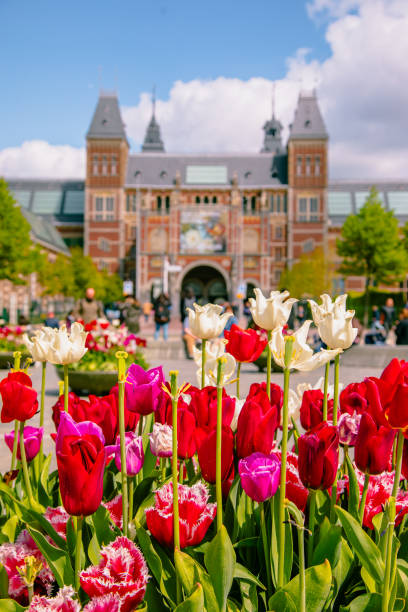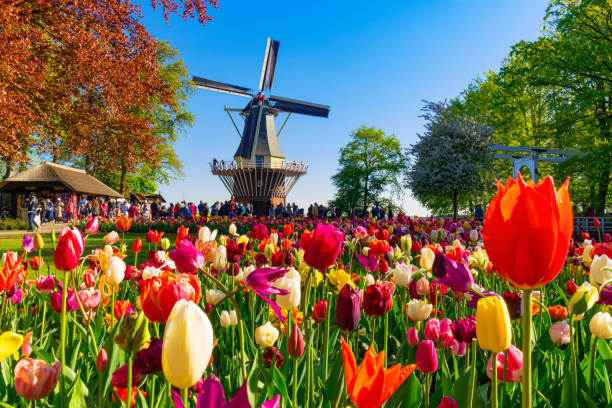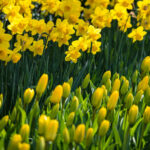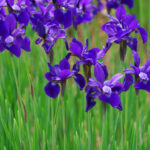The Timeless Beauty of Tulips: A Symbol of Elegance and Resilience
Tulips are one of the most celebrated flowers in history, recognized for their simple elegance and striking appearance. Known for their vibrant colors and diverse shapes, tulips have enchanted gardeners, florists, and flower enthusiasts for centuries. This article explores the origins, history, types, growing techniques, and cultural significance of tulips, which continue to be a favorite in gardens worldwide.




Origins of the Tulip
Tulips trace their origins back to Central Asia, specifically the regions surrounding the Tien Shan mountains and parts of modern-day Turkey. They were first cultivated by the Turks in the Ottoman Empire around the 10th century, where they were highly regarded for their beauty. The flower’s name is derived from the Persian word “dulband,” which means turban, reflecting the tulip’s distinctive cup-shaped bloom that resembles the headgear.
By the 16th century, tulips were introduced to Western Europe, largely due to the efforts of Ogier de Busbecq, the ambassador of Ferdinand I to the Ottoman Empire. Tulips quickly became fashionable among the elite in European courts, particularly in the Netherlands, where they played a key role in the country’s economic and cultural history.
Tulip Mania: A Historical Obsession
Perhaps one of the most fascinating episodes in the history of tulips is “Tulip Mania,” which took place in the Netherlands during the 1630s. At the height of this speculative bubble, tulip bulbs became so valuable that they were traded for sums comparable to the cost of a house. Some rare varieties were worth their weight in gold, leading to a frenzy of buying and selling.
Tulip Mania is often cited as one of the earliest examples of a financial bubble. When the market for tulip bulbs inevitably collapsed in 1637, many investors were left bankrupt. Despite the financial ruin that followed, tulips remained an important part of Dutch culture, becoming a national symbol of the Netherlands, a status they still hold today.
The Diversity of Tulips: A Palette of Endless Colors
One of the reasons tulips are so beloved is the incredible diversity within the species. There are over 3,000 registered varieties of tulips, which fall into 15 distinct groups based on their flower shape, bloom time, and heritage.
- Single Early Tulips: These are among the earliest tulips to bloom, featuring simple, cup-shaped flowers in a wide array of colors. They are popular for their reliability and uniformity.
- Double Late Tulips: Also known as peony-flowered tulips, these have large, fluffy blooms with multiple layers of petals. They bloom in late spring and are prized for their showy appearance.
- Parrot Tulips: With fringed or ruffled petals, often in vibrant, multi-colored patterns, parrot tulips are dramatic and unusual, making them a favorite for cutting gardens and floral arrangements.
- Darwin Hybrid Tulips: Known for their long stems and large, bold flowers, Darwin hybrids are a favorite among gardeners. They are particularly hardy and resistant to disease, making them ideal for naturalizing in gardens.
- Fringed Tulips: These tulips have petals with fringed edges, adding texture and interest to their blooms. They come in a wide range of colors and are highly sought after for their unusual appearance.
Tulips come in virtually every color except true blue. Some varieties are bi-colored, while others feature intricate patterns like streaks and flames. This diversity makes tulips one of the most versatile flowers for landscaping and flower arrangements.
Growing Tulips: From Bulb to Bloom
Tulips are typically grown from bulbs, which are planted in the fall before the ground freezes. To ensure a healthy and vibrant bloom in the spring, there are a few key steps to follow:
- Selecting the Right Bulbs: Choose large, firm bulbs for the best results. Bulbs should be free of soft spots, mold, or any signs of disease.
- Planting Location: Tulips prefer full sun and well-draining soil. If the soil is too compact or holds water, the bulbs may rot. Plant bulbs in a location that receives at least six hours of sunlight per day.
- Planting Depth and Spacing: Tulip bulbs should be planted about 6-8 inches deep and spaced 4-6 inches apart. This ensures enough room for the roots to develop and prevents overcrowding.
- Watering: Water the bulbs thoroughly after planting to encourage root growth. Once the bulbs are established, tulips generally require minimal watering unless there is a prolonged drought.
- Care During Dormancy: After tulips bloom, their foliage should be allowed to die back naturally. The leaves help to store energy in the bulb for the next year’s bloom. Once the foliage has withered, it can be removed, and the bulbs can either be left in the ground or dug up for storage.
Tulips can be grown in a variety of climates, but they thrive in regions with cold winters. In warmer areas, it may be necessary to chill the bulbs in a refrigerator for several weeks before planting to simulate the winter conditions they need to bloom.
The Cultural Significance of Tulips
Tulips have played a significant role in various cultures throughout history. In Turkey, they were seen as a symbol of paradise and perfection, often depicted in art and textiles. During the Ottoman Empire, tulips became so revered that they sparked an era known as the “Tulip Era,” which was marked by prosperity, cultural flourishing, and a love for horticulture.
In the Netherlands, tulips are deeply intertwined with national identity. The annual Keukenhof garden display, also known as the “Garden of Europe,” is one of the world’s most famous tulip festivals. Every spring, millions of tulips bloom in the Keukenhof gardens, attracting visitors from around the world to marvel at the stunning displays.
Tulips also hold meaning in the language of flowers, or floriography. They are often associated with love, particularly perfect love. Red tulips, in particular, symbolize deep passion, while yellow tulips can represent cheerful thoughts or sunshine. White tulips are associated with forgiveness, and purple tulips denote royalty.
Tulips in Modern Times
Today, tulips remain a favorite in gardens and flower arrangements due to their beauty, versatility, and symbolic meaning. They are often planted in mass displays in public parks and gardens, creating breathtaking carpets of color in the spring. Florists frequently use tulips in bouquets, as they are both elegant and long-lasting.
In addition to their aesthetic appeal, tulips have practical uses as well. Some varieties are cultivated for the production of perfumes due to their delicate fragrance. In recent years, tulip petals have even been used in culinary dishes, adding a touch of elegance to salads and garnishes.
Conclusion: The Enduring Charm of Tulips
Tulips have enchanted people for centuries with their simple yet striking beauty. From their origins in the mountains of Central Asia to their cultural significance in Europe and beyond, tulips have left an indelible mark on history. Their versatility, vibrant colors, and symbolic meanings ensure that they will continue to be cherished by gardeners, florists, and flower enthusiasts for generations to come. Whether you’re growing tulips in your garden or admiring them in a vase, these timeless flowers will always evoke a sense of grace and elegance.







